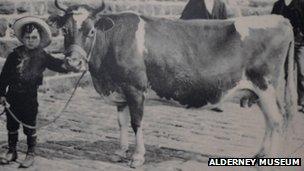Alderney cow: The breed Jerseys and Guernseys overshadowed
- Published

The Alderney Cow looked like the Guernsey breed, but was smaller, like the Jersey cow
Later this year, Guernsey will host the 14th World Guernsey Cattle Conference.
Much like the Jersey breed, Guernsey cows have enjoyed worldwide success, with herds across six continents.
However, history has not been as kind to the smaller cousin of the Guernsey, the Alderney cow, extinct from the northernmost Channel Island for more than 60 years.
The Alderney cow met its end during the German occupation of the Channel Islands, when the majority of Alderney's residents were evacuated.
Felicity Crump, a former farmer who has written articles on the breed, said its fate was sealed when the Germans arrived in 1940.
She said 374 cows were sent to Guernsey to help islanders avoid starvation and to fulfil meat quotas set by occupying forces.
'Small, poor animals'
Ms Crump states: "These were generously replaced by Guernsey after the war... [but] the replacements were pure Guernsey."
It meant, she said, the "real Alderney cow" - itself a cross-breed of Guernseys and Jerseys - had essentially disappeared, along with its special characteristics.
Documentary or first-hand evidence of this could be hard to come by though, since along with the removal of the cows, most of the islanders themselves were evacuated in 1940.
Ms Crump, said at least the animal's fame stretches to those visitors to the island's museum.
"Everybody who comes to the museum, the first question they ask is 'What about the Alderney cow?'," she said.
These people are in fact asking about a misnomer, Ms Crump says; the archaic practice of naming all Channel Island cows "Alderney cows".
She said: "In fact that cow, which is quite famous in America and in Britain... was not bred on Alderney, nearly all of them were Jersey cows."
The "real Alderney cow", as Ms Crump dubbed it, was present in the island from the 1860s until the start of the German occupation.
Ms Crump explained: "All the reports in the literature about the cows actually on Alderney before the 1860s [said they] were very small, very poor animals."
The 1860s saw huge changes in Alderney, with the construction of a number of forts.
The island's population swelled to more than 5,000 - today it stands at a little above 2,000.
Ms Crump said: "At that point in the 1860s, when the forts were all built in Alderney, and there was a huge influx in population... it was not possible for them to produce the amounts of milk that they needed."
She added: "They imported Guernseys and some Jerseys. The result was that on the island a cross-breed between Guernseys and Jerseys appeared."
Traced to America
And it was this breed that Ms Crump considers to be the "real Alderney cow".
In an article written for the Alderney Society Bulletin, she described the cross-breed: "Some had in-turned horns and dished faces like Jerseys.
"Most had robust bodies more like Guernseys, though with shorter legs and different colouring."
In the same article, Ms Crump said the animals had "a very well attached milk bag".
She said this offered advantages to the cow's movement and comfort, but also to anyone wishing to milk one.
The reputation of the Alderney cow during its 80-year reign was a good one, and saw many registered officially as Guernsey cows to allow for export to the United States.
While no "pure" Alderney cows exist any more, their blood-line can still be traced in some American herds.
- Published15 November 2012
- Published5 March 2012